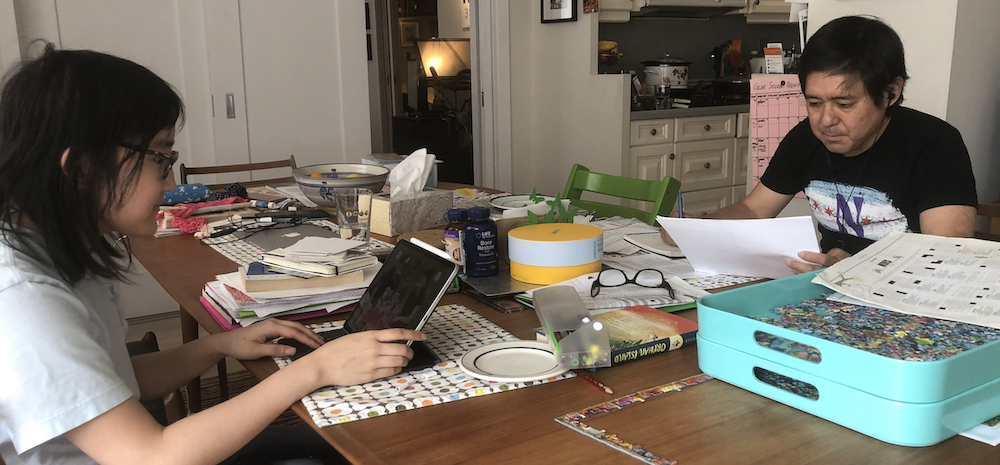Welcome to the 6th episode of “Shoots!” where I celebrate examples of 21st century entrepreneurialism emerging in unexpected places or demonstrating increasingly important business principles. I’m revisiting Instant Teams, a company featured a few weeks ago. In this installment I will:
- Highlight how a startup specifically designed for working at home still must adjust to the convergence of work, family and life the crisis dictated
- Explain why we are all experiencing similar tensions
- Share how I separate and fulfill conflicting responsibilities at home

++++++++++++++++++
Instant Teams employs military spouses to staff business clients’ virtual tech support, customer success and marketing teams. I was impressed by this startup’s ability to harness a qualified labor pool and deploy them in a nimble fashion. The Covid-19 crisis magnified the importance of working remotely and validated Instant Teams’ ability to respond to rapid change.
While I was writing the “Shoots!” article I was also conducting a survey of my extended network’s response to Covid-19 as part of a broader study on resilience (Thank you to the 250+ people who responded!). I invited Instant Teams’ co-founders Liza Rodewald and Erica McMannes to have their company participate in the pulse survey. If you are interested in having your organization’s pulse taken, please let me know!
I received 50 additional survey responses from women in the “Instant Teams Cohort” consisting of Instant Teams employees, as well as others staffing or awaiting assignment to client teams (all members of this cohort are both military spouses and women).
High Stress Within a Well-Situated, Resilient Workforce
Nearly all (94%) of women in the Instant Teams Cohort reported their current stress levels to be at or greater than levels prior to the crisis, with well over half of the entire cohort reporting higher levels of stress. These numbers surprised me because the group is:
- More prepared: military families are used to constant moves and uncertainty
- Younger: less likely to contract and be physically impacted by Covid-19 themselves
- Married: not living alone; with few exceptions spouse is not deployed
- Able to connect virtually: already heavy users of FaceTime, What’s App, etc.
- Less affected by the unemployment surge: spouse remains employed by military, demand for remote staffing has increased
- Already working remote: Instant Teams’ business model assumes remote working; the co-founders are based in Hawaii and Virginia, respectively
- Not living in major Covid-19 epicenters
As Anne Schons, Instant Teams’ Head of Organizational Development described to me from her home / office in Iowa, much of the Instant Teams Cohort had achieved equilibrium prior to the pandemic. They procured a job working at home that fit within their schedule and location constraints. Their earnings contributed to the family budget. Those with young children arranged for school or daycare. They set up a dedicated workspace for themselves. All of this is often elusive for more transient military families
Instant Teams’ Response to a Disrupted Equilibrium
Then within a span of a few weeks, Covid-19 forced all of us, the Instant Teams Cohort included, to confine all aspects of our lives to our homes: work, kids’ schooling, socializing, exercise, leisure time and sleep. It’s both the breadth of changes and the speed at which they have happened that’s been jarring. Liza observed, “None of us were expecting such a dramatic shift in our way of life right now…this is a family / life / remote work issue all bundled into one.”
Instant Teams remained as resilient as possible, addressing team members’ disruption of their home / work environments on multiple fronts:
- Must-have hardware and software to maximize productivity
- Creative scheduling that balances business needs with employees’ home commitments
- Core hours overlapping with team members across time zones from the East Coast to Hawaii
- Flexible hours at the beginning and end of days to juggle family and work responsibilities
- Color-coded heart-shaped indicators in Slack, a communication platform used by many remote companies. The color allows each person to indicate how she is feeling
- Pink exclaims “I’m doing great!”
- Green: “I’m good, no complaints”
- All the way down to black, which signals “I’m having a hard time today”
- This indicator discreetly opens the door to judgement-free 1-on-1 outreach
Indicators to invite proactive outreach are especially important when working remotely, where it’s impossible to observe how people are feeling and group video calls do not lend themselves to connecting emotionally.
This Applies to All of Us!
If those who are well-prepared and capable of working remotely like the Instant Teams Cohort feel an impact of this crisis then certainly anyone transitioning to working from home will.
Some of you have experienced a “Take Your Daughter or Son to Work Day” at a large corporation. My employers used to plan extensively – select employees spoke to kids about their jobs, children crammed into the New Yok video conference room to talk to offices in Atlanta and Salt Lake City and professional clowns frightened toddlers.
This year, “Take Your Daughter or Son to Work Day” fell on April 23, so we didn’t miss it despite the pandemic. Rather, it was extended indefinitely! But it came without special activities, entertainers or co-workers’ children hanging out with yours. Your kids can still explore the pantry, mailroom and copy room you use for work, but each has been relocated and severely downsized to your home.
Whenever my daughters visited my workplaces for this event or other occasions, I felt both joy and apprehension. They loved visiting the office. I was proud to have my kids meet colleagues but I didn’t want them to distract anyone. I worried about them bickering over whiteboard markers, running to the bathroom noisily or leaving the spigot of the water cooler open. And inevitably, I would not finish “what I needed to,” and make them wait. I remember rushing through meetings and feeling a lot of pressure during those few precious hours.
I am feeling similarly torn now, but rather than it being compartmentalized and only occurring a handful of days a year, dissonance looms throughout my home. As parents, we used to be either at work or at home, family members spent hours in different locations playing worker and parent roles separated by time and space. Whether purposefully or by default, we made daily choices: should I stay at the office or make it home for dinner? We made some quarterly: should I attend the parent/teacher conference? And we experienced rare unexpected interruptions: did I hear what happened at school today?
Now, the decisions are seemingly never-ending, wide-ranging and with no discernible pattern. Moreover, yes or no work / family decisions now are shades of gray. If I do a Zoom meeting now, will I disruptive to the girls or my wife? What should we make for dinner? Is my wife working or concentrating on something else? When should we do the laundry? Do I have to apologize for snapping while editing a document at the dining table? What’s going on the kids screens – are they really attending class?

Even when we plan our days, the number and range of “micro-decisions” have grown considerably. Recently, I flipped between work to study hall proctor to cook to physical therapist trainee, all within 10 minutes.
What Am I Doing?
Here’s a short list. First, I recognize this crisis has obliterated lines between being a business owner / husband / parent / regular guy. I must consciously re-draw distinctions between roles and when I am performing each.
Second, I am compartmentalizing different activities. I “commute” to spaces within my home conducive to thinking, writing, contacting people, researching and analyzing and focus on a single activity for dedicated time periods. Depending on the task, that time block can be as short as 15 minutes. These discrete spaces may be chairs a few feet apart facing different directions. I have the right equipment available (and leave others behind): a pen and paper, headphones and music, computer, multiple monitors, mobile phone or a printed document. My wife and I have different working styles, so we often need to physically separate from one another. Most important, I create “work-free” blocks of time to clear my head and do a better job of relaxing.
Finally, I am striving to temporarily escape my confines by connecting 1:1 with people. I have gotten a lot out of Zoom calls, catching up with more people over the past two months than I would have during normal times. But I miss in-person gossiping with a co-worker in my office, focused dinner conversation with another couple or stumbling through a tailgate and football game with a buddy. Purposely phoning or writing individual emails to dear friends not only helps them now but it also helps me. As I’ve stated in a recent YouTube video called the Resiliency Network, we are more resilient when we are connected with others. Resiliency is contagious and it can be spread even in the social distancing era! I need to do it a lot more.
What are you employing to mitigate the collision of work, family during this pandemic? What other steps are you taking to move beyond the crisis? Please share your tricks with me; I am eager to add them to my toolkit!
Kyle Okimoto is the founder of Market Junctions, which helps transform the power of disruption into a force of positive change. He is the creator of the Resiliency Map, a process anyone can use to increase their resilience by drawing from their own experience and that of others. He is the Acting Chief Marketing Officer for Trade Exchange, a marketplace for investment ideas and an investor and advisor in startups ranging from Cadence (high yield short term alternative investments), AltoIRA (self-directed retirement accounts for alternative investments), ARIS Technology (robotic quality control laser scanning). Kyle has no financial interest in Instant Teams.


